When I write one of these articles I first do some research. I might think I know a plant quite well but I always learn some more in the process of looking in various places. I need to make sure of the botanical name, where it comes from and if possible I like to know who discovered the plant and why it was named. I also like to make sure I know the best way to grow it and what to expect in climate, pests and disease. It is not just it’s looks and scent which are important, it’s a total of all aspects of the subject that help to inform me if this is the kind of plant to I would recommend. Without a doubt there will always be some mysteries I can not figure out. One such plant for me is the Echinops (Globe Thistle) that is seen growing in gardens for I can not say for sure ‘which species is which’ with any great authority. In this case it really does not matter as all Echinops are shining stalwarts in the garden and should be grown more.
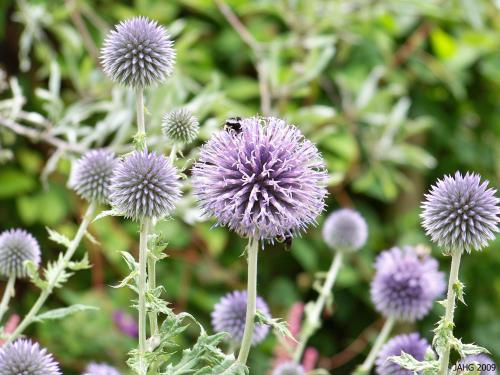
A beautiful steely blue Echinops ritro, the most commonly seen species in the Victoria.
Echinops have been known and noted in writing as early as the 16th century, it was Linaeaus who gave them their formal name in 1753. Echinops Latin name meaning is very descriptive; echinos(hedgehog) ops(looks like), put it together and you have an ‘Looks-Like -a-Hedgehog’ plant! Globe Thistle are old world plants which means they come from Europe and spread through parts of Asia and northern Africa. Not surprisingly theses are members of the Asteraceae(Compositae) family which many other thistley things belong. All members of this family have composites of many tiny flowers which are close together. The Echinops flower structure is a good example of this, each of it flower ‘spheres’ is just that; a ball of tiny flowers close together.
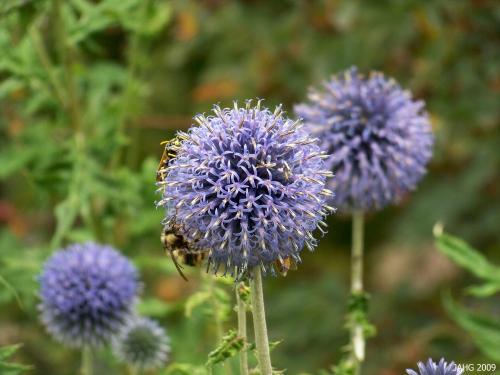
Echinops or Globe Thistle are a good example of a Composite flower.
Many people do not think of spiny plants as being attractive garden plants and Echinops show how wrong we are about this. All parts of this plant are beautiful, the leaves are whether they are grayish or bright green are thick and leathery and stand up well through the seasons. the spherical balls which turn into the flowers are stunning during their whole development. The overall silvery grayness works very well in with many colors in the garden and this makes Globe Thistles very versatile.
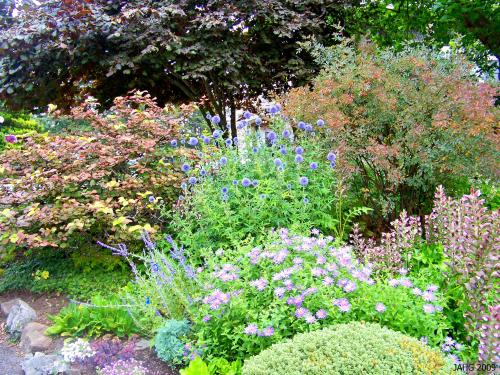
A favorite planting at Government House with Echinops as the star at this time of the year.
We must consider ourselves lucky as Echinops are extremely easy to grow and are very hardy. Like all slightly silvery plants Globe Thistles like as much sun as they can get, full sun is the best to bring out the fullness of color. Full sun will also help combat any possibility of mildew discoloring the foliage. Average soil will do. Less than average amounts of water is better, these plants do quite nicely in drier situations and are less prone to disease. Echinops are all large plants which can reach 2m(6ft) in height and nearly as wide.
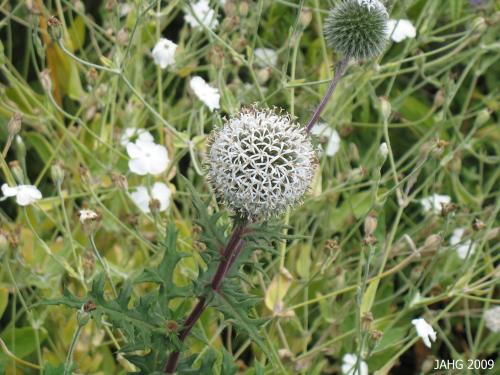
This appears to be Echinops spaerocephalus with it's maroon toned flower stem.
Generally Echinops are considered hardy to zone 4(-20c) but I have read about situations where they live in places with temperatures regularly going down to -40f(-40c) or zone 3a. Echinops flowers are excellent in arrangement and as dried subjects they should be harvested before the pollen shows. Globe Thistles are prickly but not so much as to be really dangerous.
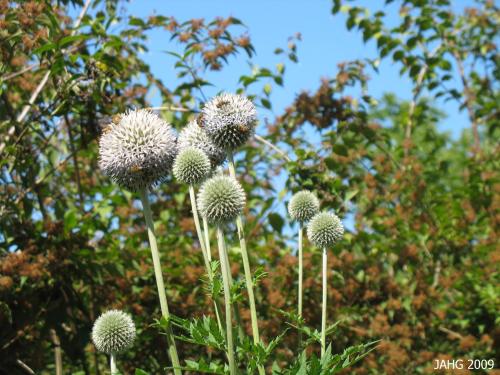
This Echinops exaltatus looks other worldy floating in the trees.
The many shades of blue, the silvery overtones on the foliage and unusual flowers, what more could one ask for in a plant? I like the foliage hairy, prickliness which contrasts with all the other smooth leaves which usually surround Echinops. It makes me think of the common thistles living here and makes me wonder how one might use them in a landscape. When looking to buy a Globe Thistle you can choose a named form which will give the certainty of color or you can grow them from seed. In species you can usually choose the blues of ritro, bannaticus, humilis and several more. Whites are commonly represented by exaltatus and sphaerocephalus . Seed is easily germinated with no special tricks needed.
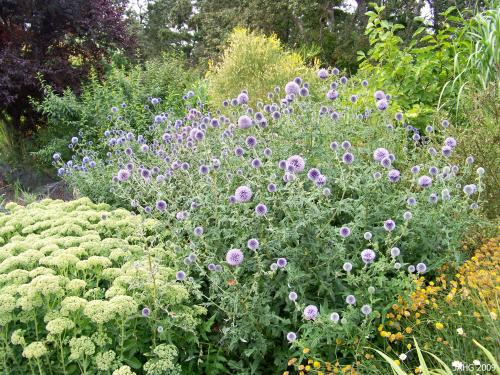
A great Globe Thistle planting at Finnerty Gardens with late summer colors.
Now is the time to Look for Echinops in gardens, the late summer heat here has produced a bumper crop this year. I have found them in many of the larger public parks which have perennial borders. Usually they are far enough in the plantings so that no one has to worry about little ones grabbing them and being surprised or scratched.
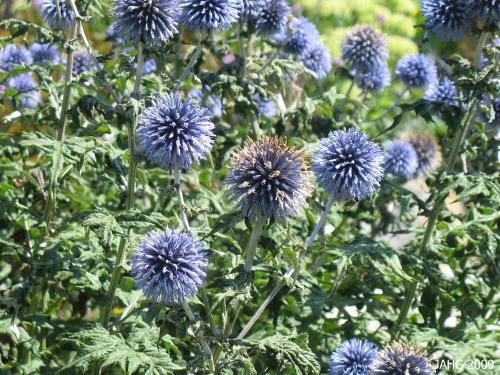
This very blue Echinops is at Glendale Gardens in Saanich.
More information on Echinops:
The Asteraceae family and their intricate flowers: http://en.wikipedia.org/wiki/Asteraceae
Look at the middle of this page to see what others have to say about growing this plant: http://davesgarden.com/guides/pf/go/634/
Growing Globe Thistles: http://www.garden-grower.com/flowers/echinops.shtml
Until we meet again Later….
 Stumble It!
Stumble It!






